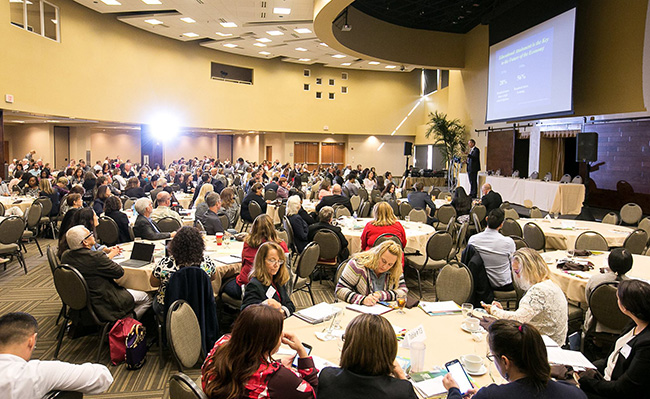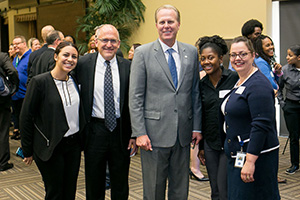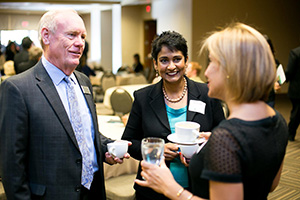
On November 5, more than 500 educators, job seekers, career counselors, economic and workforce development professionals, and policymakers gathered at the Jacobs Center for the San Diego Workforce Conference 2015: Identifying, Tackling and Closing the Skills Gap. The San Diego Workforce Partnership (SDWP) and the San Diego and Imperial Counties Community Colleges Association (SDICCCA) held the one-day conference to release three reports covering in-depth workforce data on small business, middle-skills jobs, and workforce-related initiatives that address the skills gap in San Diego County’s five Priority Sectors.
 “Our regional unemployment rate continues to decrease, but employers report thousands of jobs going unfilled due to a workforce skills gap,” says Peter Callstrom, SDWP CEO. “The information presented at the Workforce Conference will help drive a regional plan to identify, tackle and close the skills gap that remains in our regional economy.”
“Our regional unemployment rate continues to decrease, but employers report thousands of jobs going unfilled due to a workforce skills gap,” says Peter Callstrom, SDWP CEO. “The information presented at the Workforce Conference will help drive a regional plan to identify, tackle and close the skills gap that remains in our regional economy.”
The conference included an overview of each report with panel discussions from industry experts and employers, including representatives from Kaiser Permanente, Port of San Diego, GroundMetrics, and more. Discussions included:
- Small businesses’ hiring needs
- Challenges small businesses are facing in finding qualified employees
- Types of skills, educational attainment and experience required by employers
- Challenges of earning a self-sufficient wage in San Diego County
- Middle-skill job opportunities in Health Care, Information & Communication Technologies, and Advanced Manufacturing that provide a self-sufficient wage
- Trends in public-private initiatives aimed at closing the skills gap
 One of the reports released was San Diego County Middle-Skill Jobs: Gaps and Opportunities. The report was a special project by JPMorgan Chase & Co. Through its New Skills at Work (NSAW) initiative, JPMorgan supported local research and commissioned the San Diego Regional Economic Development Corporation and SDWP to identify opportunities and challenges in San Diego’s skilled jobs. JPMorgan Chase is investing $250 million over five years in the NSAW initiative to help markets build a demand-driven workforce development system, and to prepare youth and adults for careers in high-demand, middle-skill occupations.
One of the reports released was San Diego County Middle-Skill Jobs: Gaps and Opportunities. The report was a special project by JPMorgan Chase & Co. Through its New Skills at Work (NSAW) initiative, JPMorgan supported local research and commissioned the San Diego Regional Economic Development Corporation and SDWP to identify opportunities and challenges in San Diego’s skilled jobs. JPMorgan Chase is investing $250 million over five years in the NSAW initiative to help markets build a demand-driven workforce development system, and to prepare youth and adults for careers in high-demand, middle-skill occupations.
“San Diego County must greatly expand its system of regional career pathways to launch young people and adults into good jobs with advancement potential,” said Myeisha Peguero Gamiño, vice president of global philanthropy for JPMorgan Chase in San Diego. “Starting with the middle-skill positions in three leading industries—health care, advanced manufacturing and information and communication technologies—we believe the report’s targeted recommendations will help meet the market’s strong demand for these middle skills, increase talent pools for the jobs and help more San Diego residents to access good jobs that enable them to support themselves, their families and the regional economy.”
The other two reports released were Small Business: Workforce Needs of Small Businesses in San Diego and Priority Sectors: Workforce Initiatives in San Diego County.
 Key findings within the three reports include:
Key findings within the three reports include:
- Educational attainment has remained relatively unchanged since 2004, yet San Diego employers expect more education and technical expertise from the workforce.
- More than 20,565 middle-skill job openings are projected to be available every year through 2019.
- An estimated 35% of San Diegans age 25 and older lack the post-secondary credentials to fill middle-skill job openings.
- The median hourly wage for middle-skill workers is $20.20 versus the San Diego median hourly living wage of $13.09.
- Public-private partnerships have been shown to generate workers with strong “foundational skills” and increase availability of talent as well as employee retention.
- Small businesses placed the highest value on previous work experience and technical skills, yet ranked soft skills (critical thinking, problem solving, communication and leadership) as the most beneficial workforce training topics.
- Common challenges across all five Priority Sectors remain, including the need to: foster STEM education in K-12, provide work experience requirements in education and training programs, improve soft skills, develop programs that result in professional licensures, and ensure programs meet employers’ real-time needs.
 During lunchtime, California Community Colleges Chancellor Brice Harris delivered a keynote address discussing the increasing demand for workers with technical skills that require some post-secondary training and in the next few years there will be a gap of one million workers with these qualifications. He spoke to how the community college system brought together the Task Force on Workforce, Job Creation, and a Strong Economy to advise the California Community College’s Board of Governors on solutions to help the system meet the workforce needs of the future.
During lunchtime, California Community Colleges Chancellor Brice Harris delivered a keynote address discussing the increasing demand for workers with technical skills that require some post-secondary training and in the next few years there will be a gap of one million workers with these qualifications. He spoke to how the community college system brought together the Task Force on Workforce, Job Creation, and a Strong Economy to advise the California Community College’s Board of Governors on solutions to help the system meet the workforce needs of the future.
“Bridging the gap between unemployed job seekers, their skillsets and in-demand jobs is the key to connecting employers with a skilled workforce,” says Callstrom. “Thank you to our co-host SDICCCA and our sponsors – JPMorgan Chase, RHA, SDG&E, Bank of America, and the San Diego and Imperial Counties Labor Council – for supporting this important work and helping us inform the regional workforce development community of what the next steps need to be to close the skills gap.”
To read the full reports, visit workforce.org/industry-reports.
To view the panel presentations, visit workforce.org/conference2015.
To view the photos from the event, click here.
